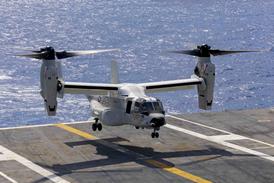Japan's aero-engine industry is poised for major expansion as it looks to add component supplier contracts with Western firms to its indigenous products.
Led by Ishikawajima-Harima Heavy Industries (IHI), Japan's aero-engine industry generated ¥247.3 billion ($2.26 billion) in revenues for the year ending 31 March 2004. Commercial engine components, driven by Japan's large workshare in the International Aero Engines V2500 and General Electric CF34-8/10 programmes, accounts for about half of this revenue stream.
Japan's commercial engine business is expected to grow through the addition of a third national project involving Boeing 7E7 engines. Japan has already secured a 15% work share in the General Electric GEnx engine, including a 10% share for IHI and 5% for Mitsubishi Heavy Industries (MHI). Kawasaki Heavy Industries (KHI) expects to receive a 10% share in the Rolls-Royce Trent 1000, in which MHI is also poised to secure a 5% share.
IHI, MHI and KHI are already united under the Japanese Aero Engines Corp (JAEC), which holds a combined 23% share in the V2500 and 30% share in the CF34-8/10. JAEC is also expected to assume project oversight in the Japanese portion of the GEnx and Trent 1000. The government is now deciding on a loan scheme to help JAEC cover its share of the development costs.
Japan is also looking to expand its fast-growing commercial engine business to include indigenous powerplants. IHI is leading a study of a potential regional jet engine that could power 50-seaters from 2010. The study team - which also includes MHI, KHI and JAEC - has already deemed the engine technologically feasible and is in the first year of a three-year research and development phase. A three-year engine verification phase could follow from 2007 to 2010.
"My dream is to build the whole engine ourselves," says an official at one of the companies. "Japan has the capability to design the full engine. From our defence business, we have total engine integration technology."
The new regional jet engine could potentially use new technologies generated during a five-year study of next-generation engines for supersonic transport (SST) aircraft that concluded at the end of June (Flight International, 6-12 July). IHI, which led the study, says new fan noise reduction and fuel nozzle technologies proven during tests of a prototype SST engine will be incorporated into the regional jet powerplant study.
Having completed the SST study, Japan has also become a potential engine supplier should an SST aircraft ever be developed. A supersonic business jet (SSBJ) could be realised within the next decade, but IHI expects such aircraft to be powered, at least initially, by a modified existing engine rather than a new-technology engine. If subsequent larger SSBJs are developed, they could be powered by a new engine built by IHI and international partners using technology incubated during Japan's SST project.
IHI also believes there are potential commercial applications for its XF7 engine, developed for the Kawasaki P-X maritime patrol aircraft. But the government must lift its export ban on all defence products for the XF7 or variants to be sold commercially.
So far, Japan has manufactured only complete engines for the defence sector. Some of these were locally developed but most were developed abroad and built domestically under licence.
In the last fiscal year, the Japan Defence Agency accounted for ¥100.6 billion in revenues for Japan's engine manufacturers, or about 41% of the total revenue stream. But declining sales of military aircraft in Japan is expected to hit these revenues, which the engine manufacturers hope to offset with gains in their commercial manufacturing and commercial maintenance lines.
Source: Flight International























